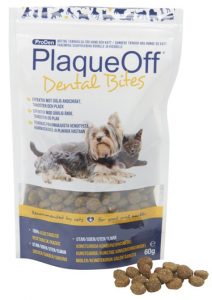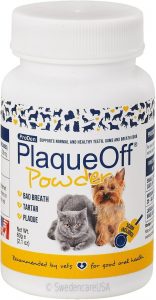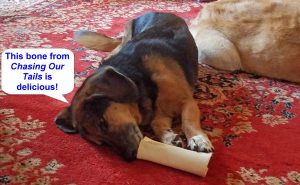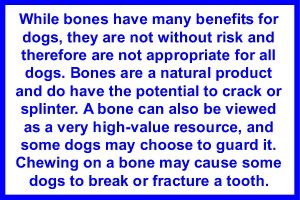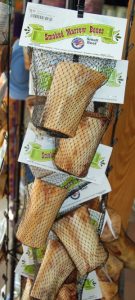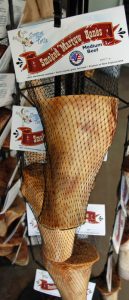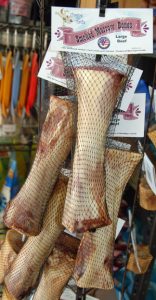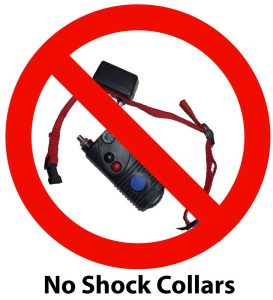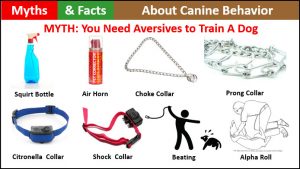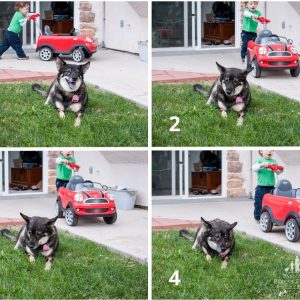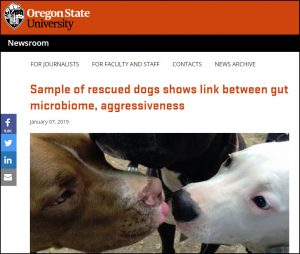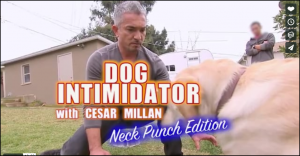< Updated 02FEB19 >
< A version of this article was published in the January 2019 issue of Downeast Dog News >
< A short link to this article on my blog – < http://bit.ly/Things-Aversives-1 >
< A short link to all the articles in this series – http://bit.ly/ThingsIWishIHadKnown >
 In September I wrote the 1st of a series of columns entitled “Things I Wish I Had Known Before I Started Training Dogs” [ FMI – http://bit.ly/Things-Gus-Dominance ] which I have since renamed Things I Wish I Had Known Before I Selected My First Dog, because there are things I will be sharing that are not about training.
In September I wrote the 1st of a series of columns entitled “Things I Wish I Had Known Before I Started Training Dogs” [ FMI – http://bit.ly/Things-Gus-Dominance ] which I have since renamed Things I Wish I Had Known Before I Selected My First Dog, because there are things I will be sharing that are not about training.
This month I am addressing the next stage in Gus’ training.
In 1991, dogs were routinely trained with collars explicitly designed to administer an aversive; positive punishment or negative reinforcement. At the time there were two primary types of training collars; choke collars or prong collars.
Choke collars are typically made of a metal chain or nylon. They are used to give a “leash pop” or “correction” when the trainer quickly 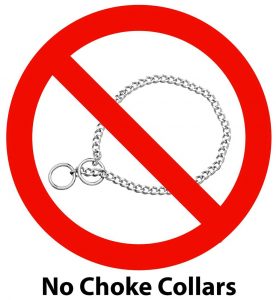 jerks the leash. The intent is to cause the dog discomfort or pain around their neck.
jerks the leash. The intent is to cause the dog discomfort or pain around their neck.
A single correction with a choke collar may restrict breathing, cause damage to the spine, the thyroid gland, and even to the eyes. The use of choke collars has also been reported to cause brain damage.
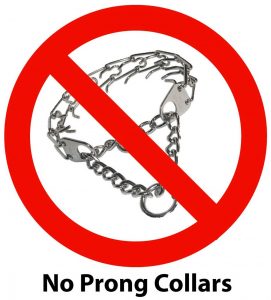 Prong collars, also called pinch collars, consist of a metal chain that contains several prongs that rest against the dog’s neck. Just as with the choke collar, the trainer jerks on the leash causing the prongs to press against the dog’s neck causing pain or discomfort. Prong collars, like choke collars, can cause both physical and psychological injury to a dog.
Prong collars, also called pinch collars, consist of a metal chain that contains several prongs that rest against the dog’s neck. Just as with the choke collar, the trainer jerks on the leash causing the prongs to press against the dog’s neck causing pain or discomfort. Prong collars, like choke collars, can cause both physical and psychological injury to a dog.
The fundamental training philosophy behind the use of choke and prong collars is to set up a training scenario where the dog will react inappropriately (e.g., the dog does not sit when cued or the dog pulls on leash) whereupon the trainer administers a correction by jerking on the leash. This jerk causes an aversive or pain which is meant to deter the dog from misbehaving in the future.
The Merriam Webster Dictionary defines “aversive” as “Tending to avoid or causing avoidance of a noxious or punishing stimulus – behavior modification by aversive stimulation.”
I find the above definition somewhat cumbersome and unclear, so I define an aversive as;
“An aversive is anything that makes your dog anxious, afraid or uncomfortable. An aversive makes our dogs want to be away from whatever they believe caused the aversive. If they believe we caused the aversive, they will no longer want to be near us.”
Since most people get a dog to be their companion, I have to ask; why would anyone want to use a tool that would cause our best friend to want to avoid us? Today it makes no sense to me. Unfortunately, not knowing any better back in 1991, the next stage of Gus’ training involved the use of a choke collar.
We taught Gus to sit, to lie down, and to stay when he was given a verbal cue by using a correction with a choke collar. We worked on the heel but never mastered it without using the choke collar; something fairly common with dogs trained in this manner. Gus never had a reliable recall until we discovered reward-based training.
There are those who use choke and prong collars that will insist that when used correctly there is no pain involved with the use of these tools. They are either in denial, do not have a thorough understanding of operant conditioning and the science of learning, are being dishonest to themselves and anyone that they recommend use a choke or prong collar, or just don’t care because “Hey, it’s just a dumb animal.”. Choke and prong collars were specifically designed for two purposes; to administer positive punishment or negative reinforcement as part of a dog training regime.
With a skilled trainer, both choke and prong collars can accomplish the task of training a dog. However, neither collar was meant to be used on the dog for life. If someone is still using these devices a year after they “trained” their dog, the training was obviously not successful.
Even though these tools can work, based on what science has taught us about dogs and how they learn, those in the pet care profession that believe in continuing education, know there is no acceptable use for choke or prong collars today. Dr. Lisa Radosta, a veterinarian and a Diplomate of the American College of Veterinary Behavior, put it best in the 2017 documentary film Dogs, Cats, and Scapegoats where she stated “If your trainer is still using pinch collars and choke collars they haven’t read a book or gone to a scientifically based seminar in 25 years.”
Positive punishment uses an aversive stimulus with the intention of  stopping a behavior such as a dog pulling while on a leash. If the dogs pulls, the handler jerks on the leash, administering an aversive pressure around the dog’s neck until the dog stops pulling and the dog returns to the side of the handler causing the leash to go slack. The handler continues to do this everytime the dog gets out of the heel position, with the hope that the dog will never pull again so that they avoid the aversive. An example of positive punishment with people would be someone getting a ticket for speeding or parking inappropriately. How many of those people go on to repeat the offense? While positive punishment works some of the time, it often fails.
stopping a behavior such as a dog pulling while on a leash. If the dogs pulls, the handler jerks on the leash, administering an aversive pressure around the dog’s neck until the dog stops pulling and the dog returns to the side of the handler causing the leash to go slack. The handler continues to do this everytime the dog gets out of the heel position, with the hope that the dog will never pull again so that they avoid the aversive. An example of positive punishment with people would be someone getting a ticket for speeding or parking inappropriately. How many of those people go on to repeat the offense? While positive punishment works some of the time, it often fails.
Negative reinforcement uses an aversive with the intention of causing a behavior to occur by administering something aversive until the dog performs the desired behavior. For example, if a trainer wanted a dog to sit, they would use the leash to tighten the choke or prong collar to be sufficiently aversive so that the dog will sit, whereupon they will stop tightening the collar and end the aversive stimulus. In its most benign form, the alarm in your car that beeps until you fasten your seatbelt is an example of negative reinforcement. In its most nefarious application, negative reinforcement was the method used by the dungeon master as he  stretches a person on the rack until they confess. The latter is defined as torture; something viewed as being morally wrong and which is illegal in most civilized societies. I often ask myself why we still allow animals to be tortured in the name of training, especially when a skilled trainer can get the same results using rewards?
stretches a person on the rack until they confess. The latter is defined as torture; something viewed as being morally wrong and which is illegal in most civilized societies. I often ask myself why we still allow animals to be tortured in the name of training, especially when a skilled trainer can get the same results using rewards?
I am not arguing that punishment and negative reinforcement do not 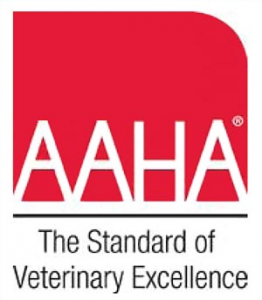 occasionally work as training methods. I am alerting you to the fact that there are significant adverse side effects to using these tools. Peer-reviewed studies indicate reward-based techniques, emphasizing positive reinforcement, work as well or better than punishment. That is why organizations such as the American Animal Hospital Association (AAHA) have policies that state:
occasionally work as training methods. I am alerting you to the fact that there are significant adverse side effects to using these tools. Peer-reviewed studies indicate reward-based techniques, emphasizing positive reinforcement, work as well or better than punishment. That is why organizations such as the American Animal Hospital Association (AAHA) have policies that state:
“This Task Force opposes training methods that use aversive techniques. Aversive training has been associated with detrimental effects on the human–animal bond, problem solving ability, and the physical and behavioral health of the patient. It causes problem behaviors in normal animals and hastens progression of behavioral disorders in distressed animals. Aversive techniques are especially injurious to fearful and aggressive patients and often suppress signals of impending aggression, rendering any aggressive dog more dangerous.
Aversive techniques include prong (pinch) or choke collars, cattle prods, alpha rolls, dominance downs, electronic shock collars, lunge whips, starving or withholding food, entrapment, and beating. None of those tools and methods should be used to either teach or alter behavior.” – 2015 AAHA Canine and Feline Behavior Management Guidelines [ Emphasis added ]
This is what I would have liked to have known about aversives before I started training.
- Aversive training tools and methods are designed to hurt, and if these
 methods did not cause pain, they would not work.
methods did not cause pain, they would not work.
- The use of aversives can cause physical injury and thus both acute and chronic pain.
- The emotional and psychological trauma caused by the use of aversives can be just as debilitating as physical injuries.
- Causing pain and discomfort is not necessary to train a dog.
- The better the relationship you have with your dog, the easier they are to train. Aversives are damaging to the relationship.
- The use of aversives can cause reactive and aggressive behaviors in a dog.
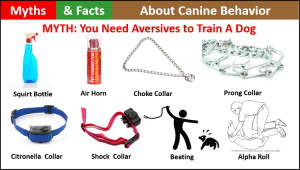
Next month I will address other aversives still used far too often to train and manage dogs.
Next month I will address other aversives still used far too often to train and manage dogs. < Click to Read part 2 NOW >
Recommended Resources
Things I Wish I Had Known Before I Started Training Dogs – Gus, the Dominance Myth, An Alpha Roll, and a Damaged Relationship – WWM-SEP2018 – http://bit.ly/Things-Gus-Dominance
What Is Dog Training? – http://bit.ly/WhatIsDogTraining
Reward Based Training versus Aversives – http://bit.ly/RewardVSAversive
Thank You, PPG, and Gus Too! – from the May 2017 issue of the Pet Professional Guild journal, BARKS from the Guild – http://bit.ly/ThanksPPG-Gus
Dog Training – How science and reward-based training have pulled dog training out of the dark ages – http://blog.greenacreskennel.com/2016/04/21/dog-training-how-science-and-reward-based-training-have-pulled-dog-training-out-of-the-dark-ages/
Selecting A Pet Care Provider – Yes! A Trend Towards Kinder and Gentler Professional Pet Care – Green Acres Kennel Shop’s “Pet-Friendly” Philosophy – Part 1 – http://blog.greenacreskennel.com/2015/04/02/yes-a-trend-towards-kinder-and-gentler-professional-pet-care-green-acres-kennel-shops-pet-friendly-philosophy-part-1/
Selecting A Pet Care Provider – Yes! A Trend Towards Kinder and Gentler Professional Pet Care – The PPG – Part 2 – http://blog.greenacreskennel.com/2015/05/02/selecting-a-pet-care-provider-yes-a-trend-towards-kinder-and-gentler-professional-pet-care-the-ppg-part-2/
<Click on the title to listen to the show>
Yes! A Trend Towards Kinder and Gentler Professional Pet Care – Green Acres Kennel Shop’s “Pet-Friendly” Philosophy
Yes! A Trend Towards Kinder and Gentler Professional Pet Care – The Pet Professional Guild and Force-Free Pet Care with Niki Tudge
Pet Behavior, Vets & The AAHA Canine and Feline Behavior Management Guidelines – Dr. Dave Cloutier – Veazie Veterinary Clinic
Other Publications & Blogs
BARKS from the Guild – May 2017 – Thank You, PPG, and Gus Too! – https://issuu.com/petprofessionalguild/docs/bftg_may_2017_online_edition_opt/58
BARKS blog – Choke Collar Pathology – http://ppgworldservices.com/2017/06/13/choke-collar-pathology/
Videos
Dogs, Cats, and Scapegoats (The entire film) – https://vimeo.com/230807934
Malignant Behavior: The Cesar Millan Effect (from Dogs, Cats, and Scapegoats ) – https://vimeo.com/243498663?fbclid=IwAR3RYOlIP7LeePV0B8ZaHhed5pPDYZbPu8KQbXNxfzOodWCRKspgcSQrwnc
Dogs, Cats, and Scapegoats – The Mind of Cesar Millan – https://vimeo.com/236013182
Position Statements
American Veterinary Society of Animal Behavior (AVSAB)
American Veterinary Society of Animal Behavior AVSAB Position Statement on the Use of Dominance Theory in Behavior Modification of Animals – https://avsab.org/wp-content/uploads/2018/03/Dominance_Position_Statement_download-10-3-14.pdf
American Veterinary Society of Animal Behavior AVSAB Position Statement on The Use of Punishment for Behavior Modification in Animals – https://avsab.org/wp-content/uploads/2018/03/Punishment_Position_Statement-download_-_10-6-14.pdf
Green Acres Kennel Shop
Green Acres Kennel Shop Position Statement on Pet-Friendly, Force-Free Pet Care – http://bit.ly/GAKS_Pet-Friendly
Green Acres Kennel Shop Position on the Use of Dominance and Punishment for the Training and Behavior Modification of Dogs – http://bit.ly/GAKS-Pos-NoPain-NoForceNoFear
Pet Professional Guild (PPG)
Pet Professional Guild – Guiding Principles – http://www.bit.ly/2mUCTqN
Pet Professional Guild – Position Statement – The Use of Choke and Prong Collars – https://www.petprofessionalguild.com/chokeandprongcollarpositionstatement
Pet Professional Guild – Position Statement – The Use of Pet Correction Devices – https://www.petprofessionalguild.com/Equipment-Used-for-the-Management-Training-and-Care-of-Pets
Pet Professional Guild – Position Statement – The Use of Shock in Animal Training – https://www.petprofessionalguild.com/shockcollars
Books
Dog Smart: Evidence-based Training with The Science Dog, Linda P. Case, CreateSpace Independent Publishing Platform, 2018 – read a review at http://bit.ly/BkRvw-Case-DogSmart
Don’t Shoot the Dog – The New Art of Teaching and Training (2ndedition), Karen Pryor, Bantam Books, 1999.
The Culture Clash, Jean Donaldson, James & Kenneth Publishers, 2005.
The Power of Positive Dog Training, Pat Miller, Howell Book House, 2001.
________________________________________________________________________
Don Hanson is the co-owner of the Green Acres Kennel Shop ( greenacreskennel.com ) in Bangor, Maine where he has been helping people with their pets since 1995. He is a Bach Foundation Registered Animal Practitioner (BFRAP), Certified Dog Behavior Consultant (CDBC), Associate Certified Cat Behavior Consultant (ACCBC) and a Certified Professional Dog Trainer (CPDT-KA). Don is a member of the Pet Professional Guild (PPG) and is committed to PPG’s Guiding Principles and the Pain-Free, Force-Free, and Fear-Free training, management, and care of all pets. Don produces and co-hosts a weekly radio show and podcast, The Woof Meow Show heard on AM620 WZON and streamed at http://www.wzonam.com/ every Saturday at 9 AM. Podcasts of the show are available at http://woofmeowshow.libsyn.com/. Don also writes about pets at his blog: www.words-woofs-meows.com. The opinions in this post are those of Don Hanson.
©01JAN19, Donald J. Hanson, All Rights Reserved
< Click for Copyright and Use Policy >
 In this episode of The Woof Meow Show from January 26th, 2019 Don interviews Dr. Katie Carter from River Road Veterinary Hospital about pet dental care and the importance of preventing and treating periodontal disease in your pet. Chronic inflammation or an infection in your pet’s mouth, gingivitis, is every bit as serious as an infection anywhere else. When left untreated, periodontal disease can spread bacteria to the liver, the kidneys, the heart, and even the nervous system.
In this episode of The Woof Meow Show from January 26th, 2019 Don interviews Dr. Katie Carter from River Road Veterinary Hospital about pet dental care and the importance of preventing and treating periodontal disease in your pet. Chronic inflammation or an infection in your pet’s mouth, gingivitis, is every bit as serious as an infection anywhere else. When left untreated, periodontal disease can spread bacteria to the liver, the kidneys, the heart, and even the nervous system.

